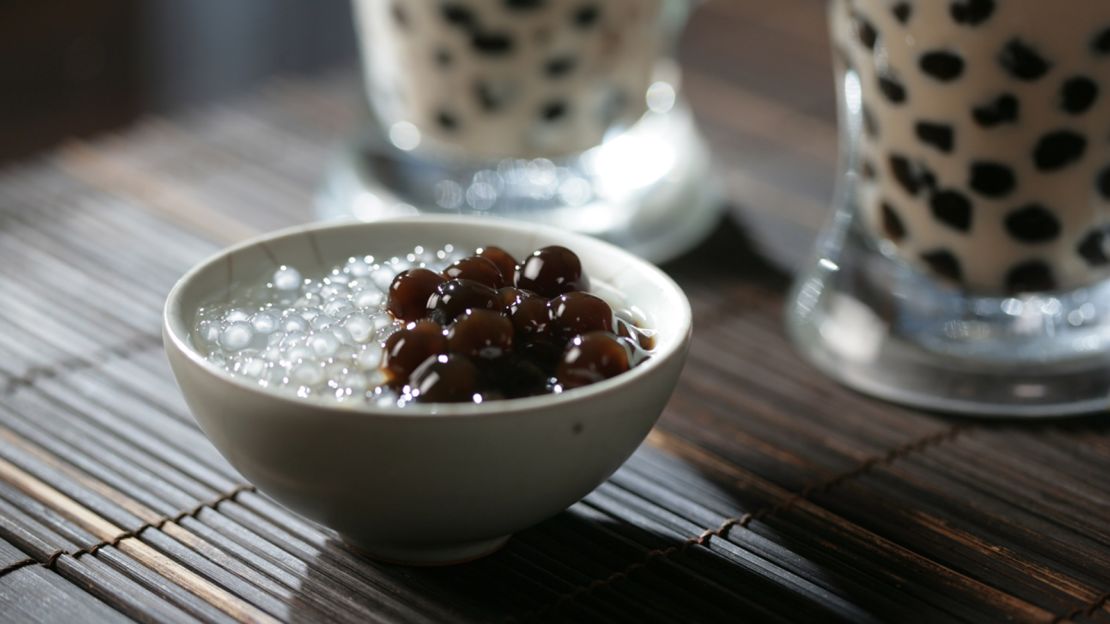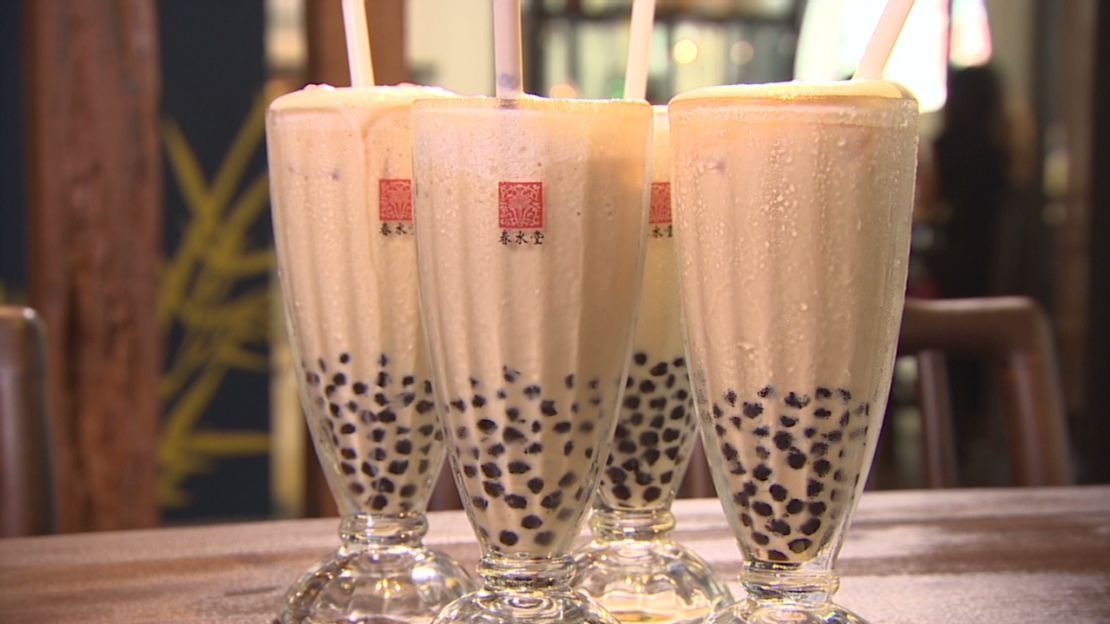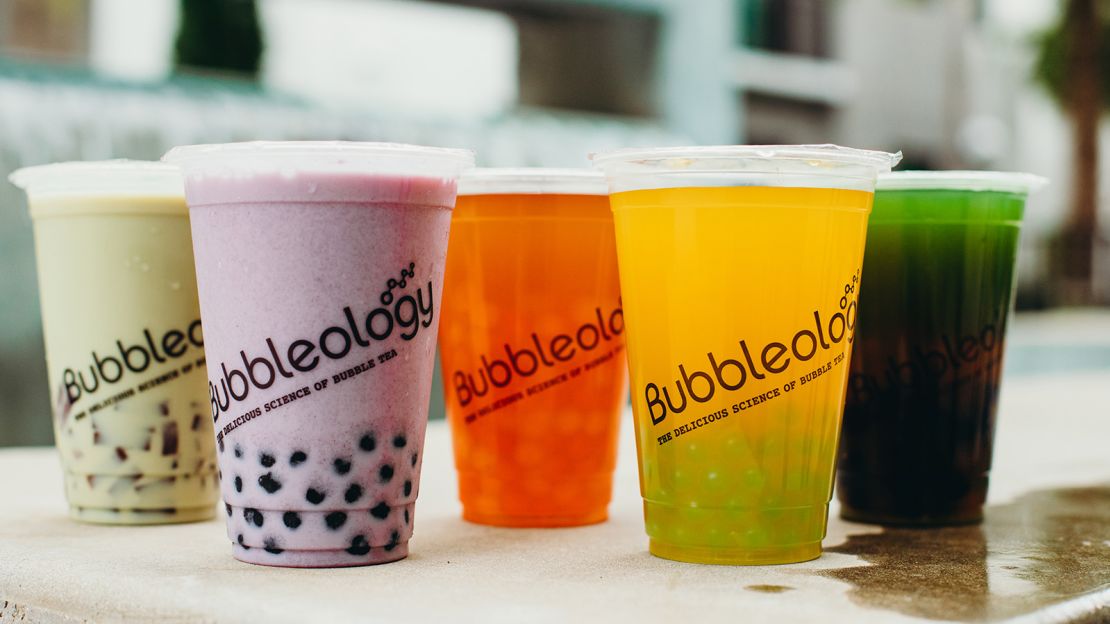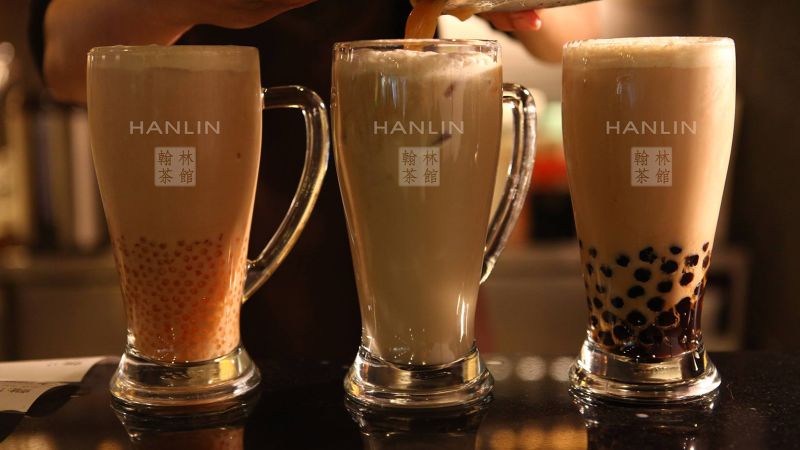What do a sexy Hong Kong icon, a bankrupted entrepreneur and a failed military defense campaign have in common?
They all contributed to the rise of bubble tea, the insanely popular Taiwanese drink that’s taken the world by storm in recent years. And now, it’s back in the spotlight thanks to recent comments by Marvel actor Simu Liu, accusing a Canadian drink business of cultural appropriation.
It all went down on an episode of “Dragons’ Den,” a “Shark Tank”-style reality show produced by the CBC in Canada. During the program, two Quebec-based beverage brand owners described bubble tea as a trendy, sugary drink, noting that customers are “never quite sure about its contents.”
Chinese-Canadian Liu, who was appearing as a guest star/potential investor, interjected, “Hang on, hang on. I am quite sure about its content,” letting them continue before proceeding to challenge them on their desire to “make it better.”
But this isn’t the first time bubble tea has been at the center of controversy. In fact, it’s been the subject of great debate for decades.
Invented in the 1980s, bubble tea (also called “black pearl tea” or “boba tea”) is a beloved Taiwan classic. Though there are dozens of different variations, at its core it’s a combination of tea, milk and the “bubbles” – which are essentially little balls made of anything from tapioca to fruit jelly.
According to various recent studies, the bubble tea industry in 2024 is valued at around $2.4-3.6 billion globally and there is no sign of growth slowing down in the next decade.
So where did it all begin?
The roots of bubble tea can be traced back to the 1940s.
After working as a mixologist in an izakaya in Taiwan under Japanese rule during WWII, in 1949 Chang Fan Shu opened a tea shop selling unique shou yao (hand-shaken) tea made with cocktail shakers.
The result was a rich and silky iced tea with fine air bubbles on top – dubbed foam tea in Taiwan.
Today, shou yao is an essential bubble tea element. No shou yao, no bubble tea.
It was a revolutionary invention at that time – not only were cold drinks uncommon, but the idea of consuming food and beverages for pleasure had only begun to grow in post-war Taiwan. In the following years, the island’s passion for tasty cold beverages intensified.
“The trend of tea beverages prospered together with the rise of the leisure food trend in the 1980s as Taiwan was experiencing rapid economic growth,” said Tseng Pin Tsang, a Taiwanese food historian.
“In addition to the industrial pre-packaged tea products, there were more tea shops on the street and tea restaurants in the suburbs.”
In 1986, the late Taiwanese artist and entrepreneur Tu Tsong He decided to kickstart a new business venture by riding on the tea shop trend.
After his previous business failed – a hot pot restaurant that went bust – Tu was left with a TWD 4 million (about $124,000) debt and desperately needed an idea to set his tea shop apart from the masses.
“I was visiting the Yamuliao wet market in Tainan when I saw fenyuan (tapioca balls), a traditional snack I loved from my childhood,” recalled Tu in an interview with CNN in 2020.
“I thought to myself ‘why don’t I add some fenyuan into my green tea.’ The white fenyuan looks almost translucent with a white center when brewed inside the golden green tea, much like my mother’s pearl necklace.
“So I coined it ‘zhen zhu lu cha’ (pearl green tea).”
Tu then experimented by adding bigger, black tapioca balls to milk tea for a richer taste and a chewier texture, which became the classic bubble milk tea most fans know and love today.
“The black bubble tea balls were bigger than the straws the market had then,” said Tu. “Our customers had to use spoons to scoop out the tapioca balls. We had to work with a plastic factory to customize straws just for our tea.”
His first bubble tea shop, Hanlin, opened its doors in October 1986.
“Bubble tea soon became a hot-selling item in the market and the steady revenue of the tea shop has helped me clear my debt,” said the businessman.
Hanlin now operates about 80 branches across Taiwan and has franchises everywhere from the United States and Canada to mainland China.
But here’s where things get tricky. Tu wasn’t the only person who claimed to have invented bubble tea.
Lin Hsiu Hui, product manager at bubble tea chain Chun Shui Tang, said she created the very first glass of bubble milk tea at a staff meeting in 1988.
Just for fun, she poured the tapioca balls she brought with her into her Assam tea and drank it.

“Everyone at the meeting loved the drink and it quickly outsold all of our other iced teas within a couple of months,” Lin told CNN Travel in a previous interview.
Chun Shui Tang staff also claimed the brand was the first to debut foam tea shaken up with a cocktail shaker.
Over the years, the fight for bubble tea supremacy grew heated. A 10-year litigation kicked off in 2009. The fight was finally settled in 2019 with a disappointing but friendly ending.
The court decided that bubble tea was a drink that any person or shop could make. It was, therefore, unnecessary to debate who created it.
“We’re all old friends in the tea industry,” commented Tu in 2020. “The lawsuit with Chun Shui Tang is a must-fight battle for truth but nothing personal. We will let the people who drink our tea be the judge.”
Though the battle for ownership has no winner, there is one undisputed fun fact concerning bubble tea’s history – the origins of its nickname, boba.
Now synonymous with bubble tea in general, the word “boba” initially referred to the large black tapioca balls used in the drink.
Most agree that it was coined by a hawker in Tainan who was inspired by Hong Kong movie star Amy Yip’s nickname, Boba, which, when loosely translated, means “champion of breasts.”
The hawker named the larger black tapioca balls “boba” to differentiate them from the smaller fenyuan normally found in tea shops.

But there’s more to Taiwan’s love for bubble tea than just taste and texture, said historian Tseng.
“It also reflects the special mood of Taiwan in that era – the feeling that the society was transitioning from old to new,” he said of the late 1980s.
“It embraces some Taiwanese age-old cultural experiences, with a touch of nostalgic emotion prevailing in this modern society.”
During the process of recreating two traditional staples – fenyuan and tea – society bonded over its shared culture and history, added Tseng.
“Bubble tea is a successful example of recreating a traditional food. It has become a symbol of Taiwanese’s self-confidence and identity.”
In other words, don’t mess with Taiwanese and their bubble tea – a lesson the island’s Defense Ministry learned the hard way.
In 2004, hoping to convince the public that a proposed weapons purchase wasn’t really that costly, the ministry put out a leaflet stating that if Taiwanese would skip one glass of bubble tea per week for the next 15 years, they could save up enough to pay for the military expense.
The campaign backfired, unsurprisingly, stirring heated opposition while bonding bubble tea makers and drinkers alike.
Bubble tea chain Easy Way argued in a press conference, “Why don’t you ask people to skip drinking Coke instead?”
The saga was dubbed the “bubble tea for arms” incident by local media. Some scholars even claimed it propelled bubble tea onto the international stage.

These days, bubble tea continues to evolve in both taste and texture.
New crops of shops pop up around the world continuously, creating their own versions of the drinks.
Taiwan brand Tiger Sugar has splurged on a new wave of tea-less bubble drinks created by using natural brown sugar-coated bubbles and fresh milk.
Younger brands have also been experimenting with adding different ingredients (Oreos, strawberries and sponge cakes, for example) into their offerings.
Traditional bubble tea shops even joined in on the creativity and continue to diversify their menus.
There have been successful brands created outside Asia as well.
Bubbleology, for example, is one of the earliest chains in the UK created by a former British investment banker. The founder, Assad Khan, said that he fell in love with the drink after trying it in Chinatown in New York in 2009 and opened his first shop in 2011.
“It was a taro bubble tea and it wasn’t anything like I’d ever tasted. The variation in texture with the tea-based beverage and tapioca balls created a unique hybrid dessert,” Khan told CNN Travel about his first impression of the drinks in an interview back in 2020.
“The best part about bubble tea is its entirely customizable nature – the fact that you can calibrate every part of the drink. You don’t find this with other offerings in the impulse snack category.”
Bubbleology has since expanded beyond the UK to the United States. It’s embraced the customizable nature of the drink, offering a rainbow-colored selection of bubble drinks.
But no matter how funky you get with the recipe, the soul of a good bubble tea has always been, well, the tea.
“We only use top-notch Sri Lankan black tea (grown in Taiwan). It has a smooth fragrance and a great aftertaste,” said the late Tu, who passed away in 2022 at age 73.
As word of his death spread, many friends and colleagues in the tea industry expressed their respects online and thanked him for relentlessly promoting the tea culture of Taiwan during his lifetime.
In his last interview with CNN, Tu said traveling among the mountains of the island in search of the best possible tea was the most enjoyable part of his job.
“Bubble tea isn’t only the root and the pride of Hanlin, it is also the highlight of Taiwan’s beverage industry,” he said. “It introduces the world to Taiwan. So it is not only important for Hanlin, but Taiwan, too.”
Read the full article here


